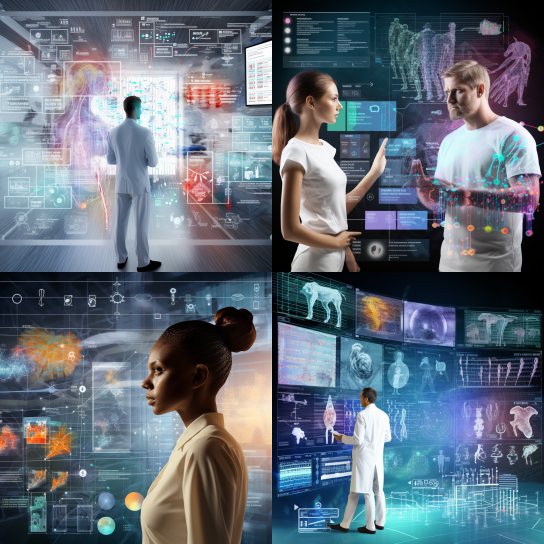Emerging applications of machine learning
Emerging applications of machine learning
Emerging applications of machine learning
Emerging applications of ML
While machine learning is already supporting a range of systems in common use – as described earlier – its potential reaches much further. In areas from healthcare to education, and transport to social services, there are signs that machine learning could support improvements to the effectiveness of products or services, through increased precision or better tailoring of interventions.
In a range of industries – where there is sufficient data available to enable machine learning methods to be developed and put to use, where this data is used effectively, and where there is access to sufficient computing power – machine learning could support a step change in the delivery of products or services over the next 5 – 10 years.
As a technology with disruptive potential, machine learning could change how businesses are organised or otherwise influence the business models used in many fields. Key to this disruptive potential is the speed of change in some fields, while in other areas there will be more gradual improvements due to machine learning. This section gives a sense of some of the applications which may be developed in the near-term, without seeking to be exhaustive.
Real "AI Buzz" | AI Updates | Blogs | Education
Potential near-term applications in the public and private sectors
Healthcare
In healthcare, machine learning could help provide more accurate diagnoses and more effective healthcare services, through advanced analysis that improves decision-making. One example of this function comes from breast cancer diagnosis. Breast cancer diagnoses typically include an assessment by pathologists of a tissue sample, in which doctors look for certain features that indicate the presence or extent of disease. A machine learning system trained on tissue images was able to achieve a higher accuracy than pathologists, by finding and utilising features of the image that were predictive but had not previously been used in the pathology assessments. In doing so, the system was able to help doctors more accurately assess a patient’s prognosis.
Education
In education, machine learning can support new ways of delivering teaching materials, especially in the online environment, and can help teachers to create personalised learning plans for individual students or carry out some routine tasks. For example, applications are being developed that use machine learning to help teachers to grade student papers more efficiently. One such application – Gradescope – scans students’ responses to questions, and groups these according to the answers given. The teacher can then review these groups, checking that the system has allocated students to groups correctly, or manually changing who is allocated to which category.
Transport and logistics
To operate safely on the roads, autonomous vehicles need to be able to recognise a range of environmental features, including: obstacles, road signs, pedestrians, and other vehicles. The range and variability of these features means that it is not possible to create hard-coded rules specifying what the vehicle will come into contact with, and how it should respond in different situations. Machine learning allows the vehicle to adapt to a range of features, and respond accordingly. Further developments in the sophistication of autonomous vehicles have applications in a wide range of settings and industries. In one example of this, Amazon is developing the use of delivery drones, with the first successful delivery taking place in December 2016.
Public services
For government, machine learning offers the promise of more efficient and effective services, through targeted interventions and tailoring of services. Examples of machine learning and predictive analytics being put to use in tackling public policy issues can already be found, both within the UK and internationally.
Finance
Machine learning is already used in banking and finance, for example in systems that detect unusual spending activity, as discussed earlier, or handwriting-recognition systems that allow automated teller machines to read cheques that have been deposited. Further applications are in development across the sector, including robot bank-tellers that use machine learning to respond to customer queries40, security systems that use voice recognition to grant customers access to their accounts, and there has been speculation that machine learning algorithms could in future help inform monetary policy-making.
Pharmaceuticals
The pharmaceuticals sector both relies on and creates large amounts of data, from clinical trials, from drug efficacy studies, or from genetic studies. These large-scale datasets require methods to aid their analysis, in order to extract valuable insights that can improve research and development processes, and to create diagnostic tools to target medicines at patients who will most benefit.
Machine learning could help increase the efficiency of the drug discovery process. For example, machine learning algorithms can analyse molecular structures of potential drug compounds, and predict which of these is likely to be more or less active. Such analysis could help increase the hit rate of screening programmes, thereby identifying more effective drug candidates more quickly.
Energy
Machine learning can be used to optimise energy infrastructure. It can analyse patterns of energy use, and use these to design systems that can respond more effectively to peak demands.
For example, Google DeepMind has used machine learning to optimise the heating and cooling requirements of its data centres, by predicting temperatures and pressures in the data centre. DeepMind’s algorithm was able to reduce the amount of energy needed for cooling by 40%. Having tested the system in a live data centre, DeepMind plans to roll it out more broadly. There may be future applications for a similar system in improving the efficiency of power plants.
Legal sector
Recent advances in natural language processing have opened a range of opportunities in the legal sector. Used alongside chatbot-style interfaces, machine learning can support systems that analyse simple legal queries and provide advice on those queries.
The reduced costs associated with such machine learning systems could help increase access to legal services in the market sector that deals with a high volume of lower value cases. Machine learning can also help carry out routine tasks, such as basic research. It may therefore challenge business models that rely on charging hourly rates, as such routine tasks may be carried out much more quickly.
Machine learning can also be used to predict compliance with the law. For example, it has been used to predict the likelihood that a company or individual will try to evade tax, by learning from patterns of transactions by companies and tax authorities, and using this to simulate how tax evasion schemes are likely to evolve, and which schemes are likely to evade detection in auditing procedures. These opportunities represent different types of disruption to traditional business models, from new ways of providing services to new ways of doing business.
Manufacturing
In manufacturing, machine learning offers an opportunity to automate processes or make them more efficient, create personalised products, or enable predictive maintenance functions. This new narrative for manufacturing in the 21st Century, whereby high-tech manufacturing exploits data-driven technologies and automation, is known as Industry 4.0.
Retail
Drawing insight from data about customers, machine learning promises increasingly personalised products, with outputs tailored to the needs or preferences of individual consumers. Machine learning can already make personalised product recommendations, for example recommending potential grocery purchases on the basis of previous shopping history, via recommender systems.
Further developments in retail could include more intensively-automated shopping experiences, such as those being developed by Amazon, in which shoppers and their shopping selections – are tracked as they move through a store, and charges are made automatically. Through a combination of sensor-based and machine learning technologies, Amazon Go is able to recognise who is purchasing which products. The result is a functional store with no checkouts.
Read More









Leave a Reply